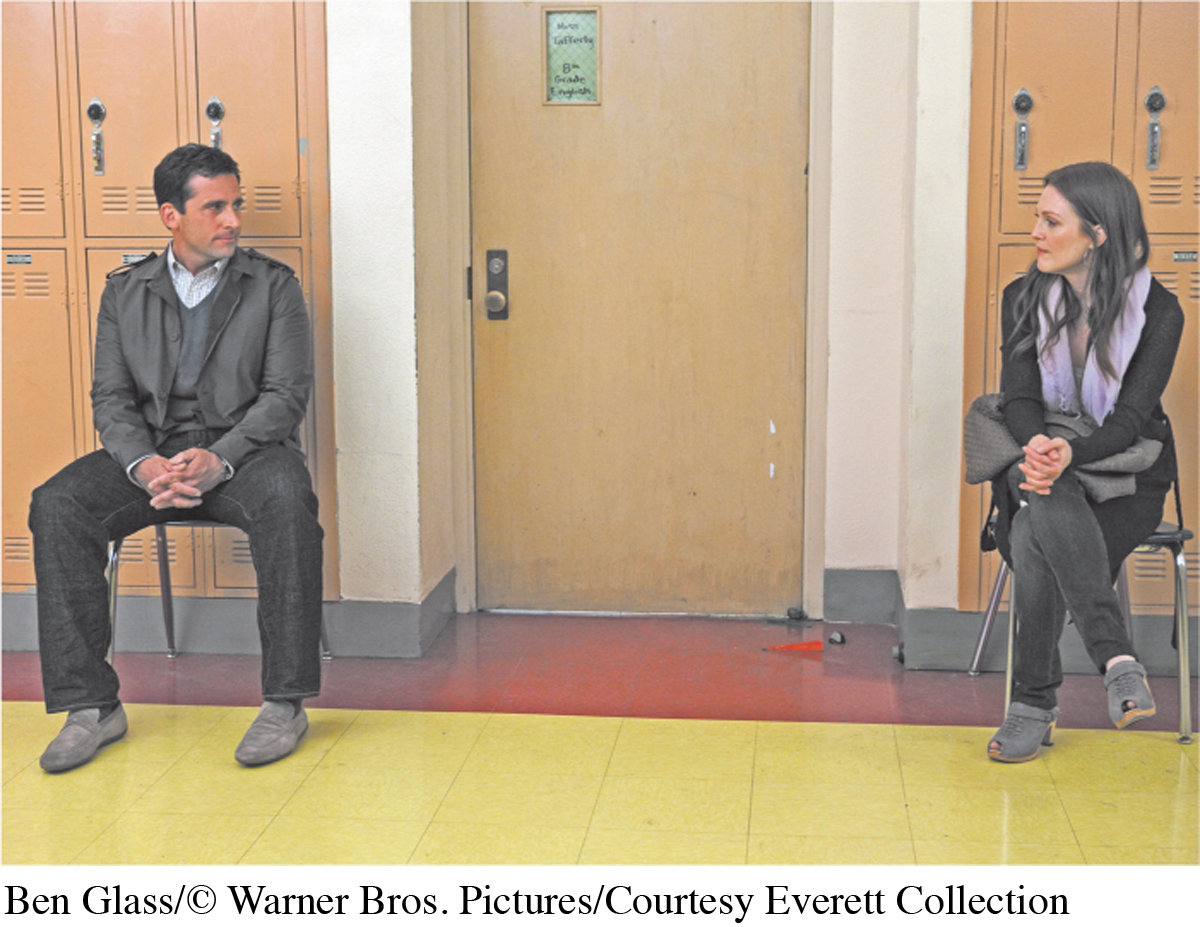What Is Interpersonal Communication?
Interpersonal communication impacts our relationships
My students frequently comment that they can’t believe how relevant interpersonal communication scholarship is to their everyday lives. After all, we cover (and this book will discuss) self-
Of course, interest in interpersonal communication has existed since the dawn of recorded history. In fact, one of the earliest texts ever written—
DEFINING INTERPERSONAL COMMUNICATION
11
Why has learning about interpersonal communication always been considered so valuable? Because knowledge of interpersonal skills is essential for maintaining healthy interpersonal relationships. For most people, having happy relationships with romantic partners, friends, family members, and coworkers is of the utmost importance (Myers, 2002).
The link that exists between relationships and interpersonal communication is clearly illustrated by our definition: interpersonal communication is a dynamic form of communication between two (or more) people in which the messages exchanged significantly influence their thoughts, emotions, behaviors, and relationships. This definition has four important implications. First, interpersonal communication differs from some other forms of communication—
self-reflection
How do you define interpersonal communication? Can interpersonal communication happen between more than two people? Can it happen through tweets, texts, or e-
Second, most interpersonal communication is transactional; both parties contribute to the meaning. For example, you and a romantic partner share an intimate dinner, jointly reminiscing about past times together and exchanging expressions of affection fluidly back and forth. But some interpersonal communication isn’t transactional. You know that your sister is feeling depressed over a breakup, so you send her a consoling text message in the middle of her workday. You don’t expect her to respond, and she doesn’t because she’s busy. There’s no feedback and no interplay between you and your sister. Instead, there is a sender (you), a message (your expression of support), and a receiver (your sister), making it a linear encounter, albeit an interpersonal one.
Third, interpersonal communication is primarily dyadic—it involves pairs of people, or dyads. You chat with your daughter while driving her to school, or you exchange a series of Facebook messages with a long-
Finally, and perhaps most importantly, interpersonal communication creates impact: it changes participants’ thoughts, emotions, behaviors, and relationships. The impact on relationships is one of the most profound and unique effects created through interpersonal communication. When we interpersonally communicate, we forge meaningful bonds with others, easing the distance that naturally arises from differences between people. We don’t have to agree with everything another person says and does, but to communicate competently with others, we need to approach them with an open mind and a welcoming heart, affording them the same attention and respect we expect for ourselves. According to philosopher Martin Buber (1965), we then perceive our relationship with that person as I-Thou.
12

13
In contrast, when we focus on our differences, refuse to accept or even acknowledge rival viewpoints as legitimate, and communicate in ways that emphasize our own supposed superiority over others, the distance between us and others increases to the point where it becomes impenetrable. As a consequence, we increasingly perceive our relationships as I-It: we regard other people as “objects which we observe, that are there for our use and exploitation” (Buber, 1965, p. 24). The more we view others as objects, the greater is the likelihood that we’ll communicate with them in disrespectful, manipulative, or exploitative ways. When we treat others this way, our relationships deteriorate.
skills practice
I-
Shifting your communication from I-
Think of someone you have to interact with regularly but with whom you have an I-
It relationship. Identify the qualities that cause you to see this person as different from or inferior to you.
Analyze these differences. Are they really a cause for concern?
Identify similarities you have with this person.
Develop a plan for communicating with this person in ways that accept and respect differences while appreciating and emphasizing similarities.
Interpersonal communication contrasts sharply with impersonal communication—exchanges that have a negligible perceived impact on our thoughts, emotions, behaviors, and relationships. For example, you’re watching TV with your lover, and one of you casually comments on an advertisement that is annoying. Within most close relationships, at least some communication has this impersonal quality. But we can shift to interpersonal at a moment’s notice. A while after the ad commentary, you snuggle up to your partner and murmur, “I love you.” You’re rewarded by warm eye contact, a tender smile, and a gentle hug—
Highlighting the mental, emotional, behavioral, and relational impact of interpersonal communication reinforces the central theme of this text: the communication choices we make determine the personal, interpersonal, and relationship outcomes that follow. Through communicating interpersonally with others, you can change your own feelings and thoughts about both yourself and others; alter others’ opinions of you; cause heartbreak or happiness; incite hugs or hostility; and create, maintain, or dissolve relationships. This power makes your interpersonal communication choices critically important.
Media Note: Buber and The Big Bang Theory
To illustrate Buber’s concept of I-
PRINCIPLES OF INTERPERSONAL COMMUNICATION
Now that you know the definition of interpersonal communication, we can expand our understanding of how it functions in our daily lives by looking at several principles suggested by scholars, based on decades of research and theory development. These principles are affirmed repeatedly throughout our text, and each one suggests practical insights into how you can improve your interpersonal communication choices, skills, and relationships.
Interpersonal Communication Conveys Both Content and Relationship Information During every interpersonal encounter, people simultaneously exchange two types of information (Watzlawick et al., 1967). Content information is the actual meaning of the words you utter. Relationship information consists of signals indicating how each of you views your relationship. These signals may indicate whether you consider yourself superior, equal, or inferior to the other person and whether you see the relationship as intimate, acquainted, or estranged.
14

You convey content information directly through spoken or written words, but you communicate relationship information primarily through nonverbal cues. These cues can include vocal tone, pitch, and volume; facial expression and eye contact; hand gestures; position in relation to the listener; and posture. For instance, imagine that you’re FaceTiming with your mom about whether or not you’re coming home for Thanksgiving. She wants you to visit, but you’d rather stay at school and work the weekend to earn money. She says, “Everyone else in the family is coming, and so we hope you can make it, too,” with a friendly tone and welcoming smile. Now imagine the exact same situation—
Relationship information strongly influences how people interpret content information (Watzlawick et al., 1967). In the preceding example, you will likely look much more to your mom’s actions than her words in deciding how she feels about you and the relationship. During most interpersonal encounters, however, people aren’t consciously aware of the relationship information being delivered. You don’t usually sit there thinking, “Gee, what’s this person trying to convey to me about how she sees our relationship?” Relationship information becomes most obvious when it’s unexpected or when it suggests that the sender’s view of the relationship is different from the receiver’s. For example, a new acquaintance says something overly intimate to you, or a roommate starts ordering you around as if he’s your boss. When such events occur, we often experience annoyance or anxiety (“Who does he think he is?!”). That’s why it’s important to communicate relationship information in ways that are sensitive to and respectful of others’ impressions of the relationship while staying true to your own relationship feelings.
15
Because relationship information influences how people interpret content information, it can be considered a specific form of meta-communication—communication about communication (Watzlawick et al., 1967). Meta-
Interpersonal Communication Can Be Intentional or Unintentional During interpersonal encounters, people attach meaning to nearly everything you say and do—
self-reflection
Consider an instance in which you didn’t intend to communicate a message but someone saw your behavior as communication. How did this person misinterpret your behavior? What were the consequences? What did you say and do to correct the individual’s misperception?
16

Interpersonal Communication Is Irreversible Every time you communicate interpersonally, you and the other person affect your future communication and the quality of your relationship. Take the way you answer your cell phone when your brother calls. The ringtone prompts you to look at the incoming number. Your warm and enthusiastic “Hi!” or terse “Yeah?” depends on how you feel about him. Your answer, in turn, influences how the caller responds. And his response further affects your next comment.
self-reflection
Think of an encounter in which you said something and then immediately regretted it. What effect did your error have on you? on the other person or people involved? on your relationship? How could you have expressed the same information differently to avoid negative outcomes?
This interconnectedness of action makes all interpersonal communication irreversible. By tweeting, posting a message on someone’s Facebook timeline, sending a text, leaving a voice-
Interpersonal Communication Is Dynamic When you interact with others, your communication and all that influences it—
self-reflection
Recall an interaction that took a sudden turn for the worse. How did each person’s communication contribute to the change in the interaction’s quality? What did you say or do to deal with the problem?
Second, no two moments within the same interaction will ever be identical. The complex combination of perceptions, thoughts, moods, and emotions that fuels our interpersonal communication choices is constantly changing. For instance, you meet your long-